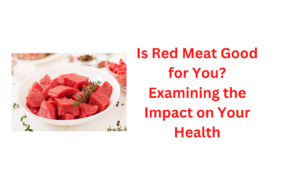Is Red Meat Good for You? Examining the Impact on Your Health
You’ve probably heard that red meat isn’t the healthiest food choice. But what does that mean for your diet and overall health? Let’s take a closer look at the effects of red meat on your body and some of the best ways to include it in a healthy diet.
The Different Types of Red Meat
There are many different types of red meat, from beef to pork to lamb. All of them are packed with nutrients that are good for your health. Red meat is a great source of protein, zinc, and vitamin B12, all of which are essential for your body.
Protein is important for tissue growth and repair, zinc is essential for a healthy immune system, and vitamin B12 is important for energy production and healthy skin. Red meat also contains high levels of saturated fat, which can have negative effects on your health if you eat too much of it.
Pros and Cons of Red Meat Consumption
There are pros and cons to red meat consumption, and it’s important to explore both before you make a decision about whether or not to add it to your diet. On the pro side, red meat is a good source of protein, iron, zinc and vitamin B12. It can also be a healthy source of Omega-3 fatty acids if you choose grass-fed beef or pasture-raised pork.
 |
| Is Red Meat Good for You? Examining the Impact on Your Health |
However, red meat also has some drawbacks. For one, it’s high in saturated fat, which can increase your risk of heart disease. It can also be high in cholesterol, which can contribute to plaque buildup in your arteries. Red meat is also a major source of environmental pollution, thanks to the way factory farms raise livestock.
How Red Meat Affects Your Cholesterol and Blood Pressure
Red meat is known to have a significant impact on cholesterol and blood pressure levels, which is why it’s important to be mindful of how much you’re eating.
Eating too much red meat can cause your cholesterol levels to spike, which increases your risk for heart disease. It can also cause your blood pressure to increase, leading to other health complications.
All of this is not to say that you should never eat red meat—just be conscious of how much you’re consuming and try to limit it to once or twice a week. There are plenty of other protein options out there that are healthier for you.
Analyzing the Connection Between Red Meat and Cancer
When it comes to the link between red meat and cancer, there has been a great deal of debate and research over the years. But the general consensus is that consuming too much red meat could increase your risk of certain cancers, specifically colorectal cancer.
That said, the American Cancer Society advises that limiting your red meat intake to 18 ounces per week can help reduce your cancer risk. This includes processed meats such as bacon, hot dogs and deli meats, which contain certain preservatives that have been linked to cancer.
If you choose to eat red or processed meats, it’s important to cook them at low temperatures and avoid burning or charring them. High-heat cooking can create carcinogenic compounds that lead to an increased risk of cancer. Also, it may be beneficial for some individuals to opt for leaner cuts of red meat and high-quality processed meats that are without added nitrates or nitrites.
How Often Should You Eat Red Meat?
When it comes to red meat, the question of how often is key. Eating too much red meat has been linked to an increased risk of certain diseases, including heart disease and diabetes. That being said, red meat in moderation can be part of a healthy diet.
The American Heart Association recommends limiting intake of red meat (beef, pork, lamb) to no more than 6 ounces per day. But if you’re not sure what 6 ounces looks like, it’s better to err on the side of caution- less is more! If you don’t want to count ounces precisely, just remember that a portion should be roughly the size of a deck of cards or your palm.
It’s also important to note that processed meats such as bacon and sausages should be avoided as much as possible due their high sodium content and cancer-linked compounds. So if you do choose to eat red meat on occasion, opt for fresh uncured cuts for the healthiest option!
Tips for Healthy Red Meat Consumption
When it comes to red meat, moderation is key. If you enjoy eating red meat and want to make sure you’re getting its benefits without the potential risks, there are some tips to keep in mind.
First of all, go for lean cuts of beef and pork with the fat trimmed off. These cuts are lower in calories and saturated fat than regular meats, making them a healthier choice overall.
Second, it’s important to watch your portion size. A typical serving of cooked red meat should be about 3 ounces – which is roughly the size of a deck of cards – although this can vary based on your individual calorie needs.
Third, try to limit your intake of processed meats like bacon, sausage or hot dogs as much as possible. Processed meats have been linked to health risks like cancer and heart disease, so it’s best to avoid them if you can.
Finally, eating a variety of foods is important when it comes to maintaining a healthy diet. Balance out your red meat consumption by including plenty of plant-based proteins like legumes and nuts as part of your meal plan.
Conclusion
So, is red meat good for you? The answer is complicated. Red meat does provide some important nutrients, but it also comes with some risks. The best answer may be to eat red meat in moderation.
